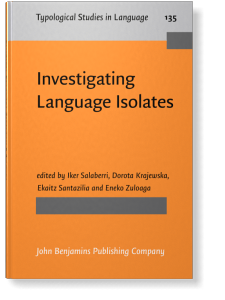Investigating Language Isolates
Typological and diachronic perspectives
e-Book – Ordering information
ISBN 9789027246295 | EUR 140.00
| USD 182.00
Language isolates provide unique insights into human history and linguistic diversity. Nevertheless, isolates have been studied less exhaustively than non-isolates. The eleven papers gathered in this volume provide new methodological tools in order to better understand isolates, including a detailed, in-depth, up-to-date discussion of what it means to be a language isolate and the criteria by which languages should be classified as isolate. The book also provides a series of techniques, some refined on the basis of former literature, and others new, in order to recover the histories of language isolates. In addition, the papers in this volume advance our knowledge about each of the individual languages studied here, which are, for the most part, endangered and under-documented. This book will appeal to a broad audience spanning typologists, historical linguists, descriptive linguists, and teachers of linguistics.
[Typological Studies in Language, 135] Expected February 2025. vii, 333 pp. + index
Publishing status: In production
© John Benjamins
Table of Contents
-
Acknowledgements | pp. vii–viii
-
Part I. Setting the stage
-
Introduction: State of the art of research on language isolatesIker Salaberri, Dorota Krajewska, Ekaitz Santazilia and Eneko Zuloaga | pp. 2–19
-
Part II. Typological features of isolates vs. non-isolates
-
Is there a typological profile of isolates?Marine Vuillermet, David Inman, Natalia Chousou-Polydouri, Kellen Parker van Dam, Shelece Easterday and Françoise Rose | pp. 22–47
-
The Amuric language family: Why so exotic?Ekaterina Gruzdeva and Juha Janhunen | pp. 48–70
-
An Austronesian-type voice system in an Amazonian isolate? Comparing Movima and TagalogKatharina Haude | pp. 71–102
-
Part III. Recovering the histories of isolates
-
Etymologies in a language isolate: Methodological aspects and a proposal to evaluate their qualityJulen Manterola | pp. 104–141
-
The Small Bang: A pilot study investigating the origins of a language and population isolate through loan wordsAbbie Hantgan | pp. 142–175
-
Combining disparate lines of evidence in the study of the history of language isolates, exemplified with Mochica from Northern PeruMatthias Urban | pp. 176–207
-
The Múra doculects and Múra-Pirahã historical linguisticsFernando Orphão de Carvalho | pp. 208–246
-
Part IV. Isolates and language contact
-
Baroque accretions and isolation: A case study of grammatical complexity in complex social situations in Solomon IslandsAngela Terrill | pp. 248–269
-
California isolates: Language contact and genetic classificationCarmen Dagostino | pp. 270–303
-
Part V. Isolates and language documentation and classification
-
One language or two? The arbitrariness of isolate classifications in New GuineaAntoinette Schapper | pp. 306–333
Subjects
Main BIC Subject
CFF: Historical & comparative linguistics
Main BISAC Subject
LAN009010: LANGUAGE ARTS & DISCIPLINES / Linguistics / Historical & Comparative
